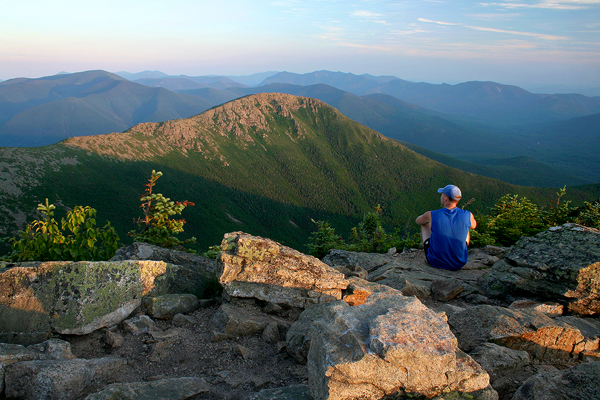Sometimes I like to know about the details of photos. So just in case anyone's interested:
-Taken from West Bond (2 hours alone on summit in July....go figure)
-Digital Rebel XT
-aperture set to f16
-shutter speed = 1/4 second
-ISO 100
-Focal length = 18mm (~28mm effective due to the size of my sensor)
-polarizing filter
-tripod
-auto-release set to 10 seconds to give me time to run over to the rocks, sit down, and stop moving
-setting sun was lighting up the cliffs nicely, so I wanted to meter on and expose for the cliffs. But I didn't want to wash out the sky, which still had a tint of nice color. Didn't mind if some of the foreground shadows got clipped, but didn't want to bleach the sky. So the cliffs aren't as orange as they could be.
-I never want to ruin a photo by including myself in it, but I was alone.....I was all I had for foreground material to give the photo more depth.
-should've shot RAW, but I wasn't shooting RAW then.
-when someone finds a camera with the dynamic range of our eyes/brains, let us all know.
Once again, thanks for all the feedback and editing.
-Taken from West Bond (2 hours alone on summit in July....go figure)
-Digital Rebel XT
-aperture set to f16
-shutter speed = 1/4 second
-ISO 100
-Focal length = 18mm (~28mm effective due to the size of my sensor)
-polarizing filter
-tripod
-auto-release set to 10 seconds to give me time to run over to the rocks, sit down, and stop moving
-setting sun was lighting up the cliffs nicely, so I wanted to meter on and expose for the cliffs. But I didn't want to wash out the sky, which still had a tint of nice color. Didn't mind if some of the foreground shadows got clipped, but didn't want to bleach the sky. So the cliffs aren't as orange as they could be.
-I never want to ruin a photo by including myself in it, but I was alone.....I was all I had for foreground material to give the photo more depth.
-should've shot RAW, but I wasn't shooting RAW then.
-when someone finds a camera with the dynamic range of our eyes/brains, let us all know.
Once again, thanks for all the feedback and editing.

